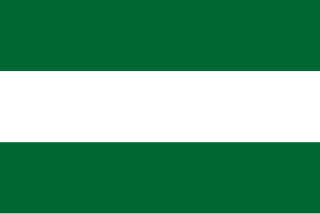
The Durrani Empire, colloquially known as the Afghan Empire, or the Sadozai Kingdom, was an Afghan empire founded by the Durrani tribe of Pashtuns under Ahmad Shah Durrani in 1747, which spanned parts of Central Asia, the Iranian plateau, and the Indian subcontinent. At its peak, it ruled over present-day Afghanistan, much of Pakistan, parts of northeastern and southeastern Iran, eastern Turkmenistan, and northwestern India. Next to the Ottoman Empire, the Durrani Empire is considered to be among the most significant Islamic empires of the second half of the 18th century.

The Chagatai Khanate, also known as the Chagatai Ulus, was a Mongol and later Turkicized khanate that comprised the lands ruled by Chagatai Khan, second son of Genghis Khan, and his descendants and successors. At its height in the late 13th century the khanate extended from the Amu Darya south of the Aral Sea to the Altai Mountains in the border of modern-day Mongolia and China, roughly corresponding to the area once ruled by the Qara Khitai.
Tughlugh Timur Khan (1312/13–1363) was the Khan of Moghulistan from c. 1347 and Khan of the whole Chagatai Khanate from c. 1360 until his death. Esen Buqa is believed to be his father. His reign is known for his conversion to Islam and his invasions of Transoxiana.
Hajji Beg Barlas was a leader of the Barlas tribe, and the immediate predecessor in this role to his nephew Timur, founder of the Timurid Empire. He was the great-great-grandson Qarachar Barlas with his lineages tracing as: Hajji Beg; the son of Burlaki Barlas; the son of Nemule Barlas; the son of Yesunte Mongke Barlas; the son of Darughachi Qarachar Barlas. During his time as a Military Commander for the Mongols, he was given the surname and title of Hajji because of his pilgrimages to Mecca. His real name "Saif al-din Barlas", and get the Beg title was given for his Chieftain or Head-Leader of Barlas Clan.
Ilyas Khoja was Khan in Transoxiana (1363) and Khan of Moghulistan from 1363 to 1368. He was the son of Tughlugh Timur.

Nasrullah Khan, or Amir Muhammad Nasrullah Bahadur Khan, was the Emir of Bukhara from 24 April 1827 to 20 October 1860. His father was Emir Haydar bin Shahmurad (1800–1826).

Moghulistan, also called the Moghul Khanate or the Eastern Chagatai Khanate, was a Mongol breakaway khanate of the Chagatai Khanate and a historical geographic area north of the Tengri Tagh mountain range, on the border of Central Asia and East Asia. That area today includes parts of Kazakhstan, Kyrgyzstan, and northwest Xinjiang, China. The khanate nominally ruled over the area from the mid-14th century until the late 17th century.
Sultan Said Khan ruled the Yarkent Khanate from September 1514 to July 1533. He was born in the late 15th century in Moghulistan, and he was a direct descendant of the first Moghul Khan, Tughlugh Timur, who had founded the state of Moghulistan in 1348 and ruled until 1363. The Moghuls were turkicized Mongols who had converted to Islam.
The Taichuud was one of the three core tribes of the Khamag Mongol confederation in the Mongolian Plateau during the 12th century, founded by Ambaghai Khan in 1148 AD, and finally ended with Sultan Husayn Tayichud in 1405 AD.

The Dughlat clan was a Mongol clan that served the Chagatai khans as hereditary vassal rulers of several cities in western Tarim Basin, in modern Xinjiang, from the 14th century until the 16th century. The most famous member of the clan, Mirza Muhammad Haidar, was a military adventurer, historian, and the ruler of Kashmir (1541–1551). His historical work, the Tarikh-i Rashidi, provides much of the information known about the family.
The Qara'unas or Negüderi were the Mongols who settled in Afghanistan after moving from Turkestan and Mongolia.
The Sufid dynasty was a Turkic dynasty of Mongolic origin that ruled in Khwarazm within the realm of the Golden Horde in the Amu Darya river delta. Although the dynasty's independence was short-lived, its later members continued to rule Khwarezm intermittently as governors of the Timurid Empire until the takeover of Khwarezm by the Shaybanid Uzbeks in 1505. Unlike earlier dynasties that ruled from Khwarezm, the Sufids never used the title Khwarazmshah.

Timur, also known as Tamerlane, was a Turco-Mongol conqueror who founded the Timurid Empire in and around modern-day Afghanistan, Iran, and Central Asia, becoming the first ruler of the Timurid dynasty. An undefeated commander, he is widely regarded as one of the greatest military leaders and tacticians in history, as well as one of the most brutal and deadly. Timur is also considered a great patron of art and architecture, for he interacted with intellectuals such as Ibn Khaldun, Hafez, and Hafiz-i Abru and his reign introduced the Timurid Renaissance.
Uwais Khan ibn Sher Ali also referred to as Sultan Vais Khan, was the Moghul Khan of Mughalistan;. He was the nephew of Sher Muhammad. In English, his name has been variously spelled and pronounced as either Awais, Owais or Vais.

Qamar-ud-din Khan Dughlat was a Mongol ruler of Moghulistan between 1368 and 1392. He belonged to the Dughlat clan of Mongol warlords.
The rulers of the Mughal Empire shared certain genealogical relations with the Mongol royals. As they emerged in a time when this distinction had become less common, the Mughals identification as such has stuck and they have become known as one of the last Mongol successor states. As descendants of Timur, they are also members of the Timurid dynasty, and therefore were connected to other royal families in the Mediterranean, Middle East, and Far East. As such, the Mughal Empire was descended from two powerful dynasties.
Khizr Khwaja Khan was the son of Tughlugh Timur and Khan of Moghulistan during the Chagatai Khanate, reigning from 1390 to 1399 AD.

The Timurid conquests and invasions started in the seventh decade of the 14th century with Timur's control over Chagatai Khanate and ended at the start of the 15th century with the death of Timur. Due to the sheer scale of Timur's wars, and the fact that he was generally undefeated in battle, he has been regarded as one of the most successful military commanders of all time. These wars resulted in the supremacy of Timur over Central Asia, Persia, the Caucasus, the Levant, and parts of South Asia and Eastern Europe, and also the formation of the short-lived Timurid Empire.
Qarachar Noyan, also spelt Karachar, was a Mongol military commander under Genghis Khan as well as a paternal ancestor of Timur, founder of the Timurid Empire.
Qurumushi or Qurmushi was an Ilkhanate commander of Keraite origin who served as Mongol viceroy of Georgia.







